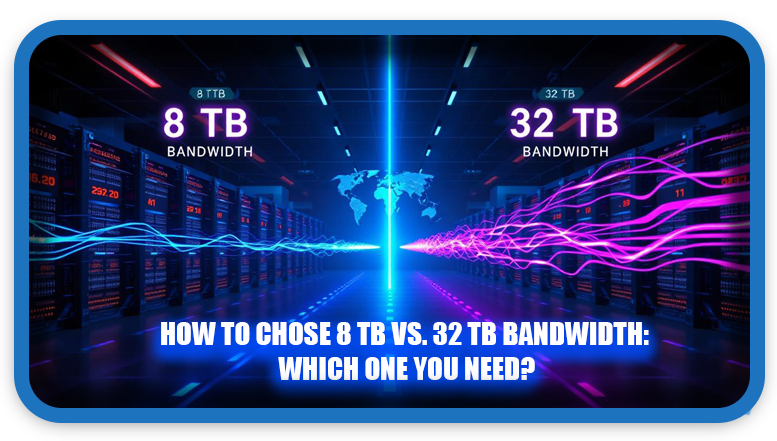⏲️ Estimated reading time: 3 min
How to Choose Between 8 TB vs. 16 TB vs. 32 TB Bandwidth: Which One Do You Need?
Are you struggling to decide between 8 TB, 16 TB, or 32 TB bandwidth for your website? Choosing the right bandwidth is essential for ensuring smooth performance, preventing slow load times, and avoiding unexpected overage fees. The right bandwidth depends on your site’s traffic, content type, and growth potential.
In this guide, we’ll compare 8 TB vs. 16 TB vs. 32 TB bandwidth, explore who needs each option, and provide expert tips to help you make the best choice.
What is Bandwidth and Why Does it Matter?
Bandwidth refers to the amount of data transferred between your website and its visitors each month. Choosing the right bandwidth helps prevent downtime, slow page speeds, and unexpected hosting costs.
Factors that impact bandwidth usage:
- Website traffic – The more visitors, the more bandwidth you need.
- Media content – Videos, high-resolution images, and file downloads consume extra bandwidth.
- Website type – A simple blog needs less bandwidth than an e-commerce or video streaming site.
- Peak traffic periods – If your site experiences traffic spikes, higher bandwidth prevents slowdowns.
8 TB vs. 16 TB vs. 32 TB Bandwidth: Which One Do You Need?
| Bandwidth Option | Best For | Estimated Monthly Visitors | Use Case |
|---|---|---|---|
| 8 TB Bandwidth | Small to medium websites, personal blogs | Up to 500,000 | Portfolios, small businesses, static websites |
| 16 TB Bandwidth | Growing businesses, media-heavy sites | 500,000 – 1 million | Online stores, news websites, video-sharing platforms |
| 32 TB Bandwidth | High-traffic websites, streaming services | 1 million+ | SaaS platforms, gaming servers, large enterprises |
How to Choose the Right Bandwidth for Your Website
8 TB Bandwidth: Best for Small to Medium Websites
- Suitable for small businesses, personal blogs, and low-traffic sites.
- Works well if your site primarily contains text and images.
- Not ideal for streaming, large file downloads, or high visitor volume.
16 TB Bandwidth: Ideal for Growing Businesses & E-Commerce
- Great for e-commerce, media-heavy blogs, and online stores.
- Can handle up to 1 million visitors per month.
- Allows for moderate video content and file downloads.
32 TB Bandwidth: Essential for High-Traffic and Streaming Websites
- Designed for large-scale platforms, cloud services, and gaming servers.
- Best for websites with global traffic and concurrent users.
- Necessary for video streaming, software distribution, or high-volume transactions.
How to Optimize Bandwidth Usage
Even with high bandwidth, optimizing your website reduces costs and improves performance. Here’s how:
Use a CDN (Content Delivery Network) – Reduces bandwidth strain by caching content globally.
Optimize images & videos – Compress media files to minimize data consumption.
Enable browser caching – Speeds up repeat visits by storing static files locally.
Monitor traffic analytics – Track bandwidth usage with Google Analytics or server logs.

Final Thoughts
Selecting the right 8 TB, 16 TB, or 32 TB bandwidth depends on your website’s size, traffic, and content type. For small sites, 8 TB is sufficient, while growing businesses may require 16 TB. Large-scale platforms and streaming sites need 32 TB bandwidth for optimal performance.
Need hosting advice? Drop a comment below!
Would you like me to tweak anything further? 🚀
Only logged-in users can submit reports.
Discover more from HelpZone
Subscribe to get the latest posts sent to your email.

